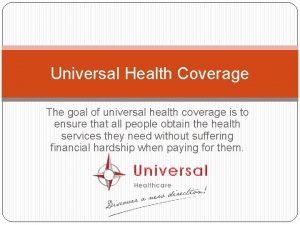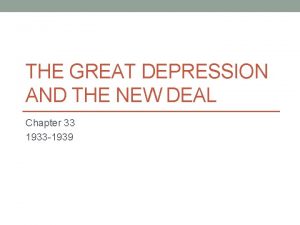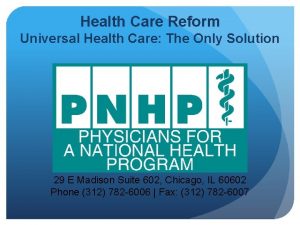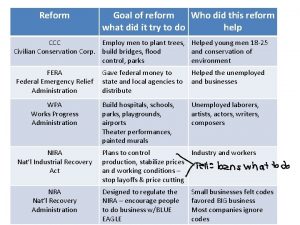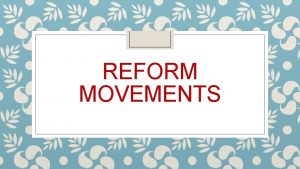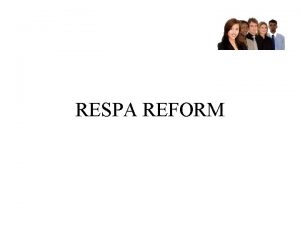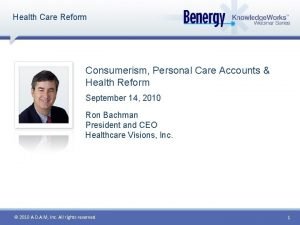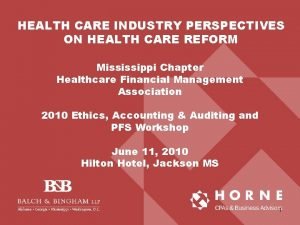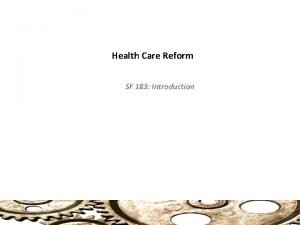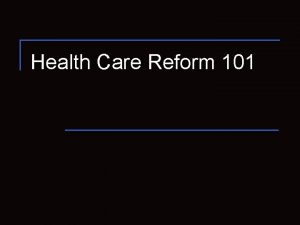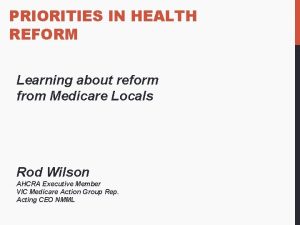Health Care Reform Universal Health Care The Only





















































- Slides: 53

Health Care Reform Universal Health Care: The Only Solution Diljeet K. Singh, MD, Dr. PH Physicians for a National Health Program 29 E Madison Suite 602, Chicago, IL 60602 Phone (312) 782 -6006 | Fax: (312) 782 -6007 email: info@pnhp. org www. pnhp. org

PERSPECTIVE - Philosophical Health care is… • A Human Right • A social service distributed according to need • Not a commodity distributed according to ability to pay • Not a business whose “beneficiaries” are company executives and investors not patients • Most Americans believe everyone should have access to good care without financial hardship

PERSPECTIVE - Philosophical • We are the only developed nation that does not provide comprehensive health care to all its citizens • 47 million Americans are uninsured • Many are underinsured - lack comprehensive coverage egs preventive care, long-term care & drug costs • 45, 000 die a year from lack of coverage • Markets are good for many things, but they are not a good way to distribute health care

PERSPECTIVE- Practical Current system is unsustainable • Burden it places on our economy/businesses • Private health insurance premiums are at unsustainable rate of 13%/year – & as much as 25% in some areas of country • Coverage is shrinking, as more employers decide to cap their contributions to health insurance & workers find they cannot pay their rapidly growing share • Most expensive health care system in the world

PERSPECTIVE - Practical • Spend twice as much as other developed nations • But we don’t get more care - Canadians, see their doctors more often & spend more time in hospital • We don’t get better results - do worse than most other developed countries on usual measures of health such as life expectancy, infant mortality, immunization rates • & we still don’t cover everyone - 47 million uninsured • In sum, our health care system is outrageously expensive, yet inadequate. Why? • There’s something enormously inefficient about the way we finance & deliver health care

Problem with For-Profit Payers • Investor-owned firms compete not by quality or costs, but by avoiding unprofitable patients & limiting services • Creates paradox of a health care system based on avoiding the sick • It generates huge administrative costs, which, along with profits, divert resources from clinical care to demands of business. • Doctors & hospitals maintain costly admin staff to deal with bureaucracy • Adminstration consumes 31% of our health care $

Solution - Single-Payer • Simpler & more efficient than our private health care system • Health care $ distributed by one entity, so that health care could be coordinated to eliminate gaps • Conceptual extension of Medicare to entire population. • Medicare is: • Government-financed single-payer system embedded within our private, market-based system. • Most efficient part of our health-care system, with overhead costs of < 3% • Covers virtually everyone over 65 • Most popular part of U S health care system

Solution - Single-Payer • Universal, Comprehensive Coverage • No out-of-pocket payments Co-payments & deductibles are barriers to access, administratively unwieldy, & ineffective for cost containment • Single insurance plan in each region, administered by public or quasi-public agency • Global operating budgets for hospitals, nursing homes, allowed group & staff model HMOs & other providers with separate allocation of capital funds Billing on per-patient basis creates unnecessary administrative complexity & expense. A budget separate from operating expenses will be allowed for capital improvements

Key Features of Single-Payer • Free Choice of Providers Patients should be free to seek care from any licensed health care provider, without financial incentives or penalties • Public Accountability, Not Corporate Dictates The public has an absolute right to democratically set overall health policies & priorities, but medical decisions must be made by patients & providers in the region rather than dictated by corporate executives. Market mechanisms principally empower employers & insurance bureaucrats pursuing narrow financial interests • Ban on For-Profit Health Care Providers Profit seeking inevitably distorts care & diverts resources from patients to investors • Protection of health care & insurance workers

47 Million Uninsured 45, 000 Deaths Per Year But simply helping them buy private insurance is not a

Meet Thomas Wilkes • Born in 2004 with Severe Hemophilia A. • Dad: Senior Engineer at a small high-tech computer firm with good benefits. • 2005: Develops an inhibitor to his hemophilia treatment. • $750, 000 annual claims.

Private Insurance for Thomas • • Company faces 40% to 55% in premiums. Only insurer that will cover them requires $10, 000 out-of-pocket & $1 million cap. • Thomas is projected to reach the $1 million benefit cap in summer 2009 • Options 1. Dad can quit job he loves & work for megafirm that will take longer to be affected by high claims 2. Mom can go to work for a mega-firm. 3. Thomas’ father can divorce his mother to leave her & Thomas legally destitute & eligible

Who Are the Uninsured? » Children » 25% » Employed » 50% » Unemployed » 5% » *Out of labor force » 20%

“…, people have access to health care in America. After all, you just go to an emergency room. ” -No Longer President Bush

America’s Underinsured Proportion of Americans Going Without Care due to Costs, 2005 (skipping doctor visit, specialist appointment, treatment or prescription when needed) Source: Commonwealth Fund Biennial Health Insurance Survey, 2005


Medical Bankruptcy Illness & Medical Bills Contributed to 1, 000 Personal Bankruptcies in 2004. (Half of All Bankruptcies) Insurance Status at Onset of Illness Uninsure d Had Insurance Source: Himmelstein, Health Affairs 2005 (state estimates provided by author)


International Health Spending, U. S. Public Spending is 2005 Greater than Other Nations’ Public/Private Spending Combined Source: OECD 2007; Japan data are from 2004

The Healthcare Americans Want • Guaranteed access • Free choice of doctor • High quality • Affordability • Trust & respect

Other Industrialized Nations • • Have similar demographics Availability of expensive technology Rising drug costs Similar levels of service Why are their costs so much lower?

Why are costs lower in other countries? • Administrative simplicity • Lower prices • Higher ratio of primary care to specialists • Health planning • Global budgets

If you were in an insurance CEO, who would you want to insure? 73% Percent of health Care Costs 80% uses less than $1000 of care per year 0% 0% 0% 1% 1% Source: Agency for Healthcare Research & Quality MEPS 2% 4% 6% 13%

The Health & Profitable to the “Market, ” the Sick & Poor to the Taxpayer 73% Government Programs Percent of health Care Costs Private Insurers 0% 0% 0% 1% 1% Source: Agency for Healthcare Research & Quality MEPS 2% 4% 6% 13%

Rising Costs = Less Benefits = Under/Uninsurance Proportion of Americans Covered by Employer Insurance Source: US Census

Life Expectancy, 2005 (Data in Years)

Infant Mortality, 2005 (Deaths in first year of life per 10, 000 live births)


Growth of Physicians & Administrators 1970 -2005 Source: Bureau of Labor Statistics & NCHS

One-Third of Health Spending is Consumed by Administration 31% Potential Savings: $350 billion per year Enough to Provide Comprehensive Coverage to Everyone Source: Woolhandler, et al, New England Journal of Medicine, August 2003 & Int. Jrnl. Of Hlth. Services, 2004


Costs to Business Skyrocketing costs for health care hurting U. S. business: • Health care cost General Motors $5. 6 billion in 2005 adding $1500 to the price of each car • Companies that offer coverage often pay 10% or more of payroll on health benefits and are at a disadvantage competing with companies that don’t offer coverage or where there is public coverage • Toyota located a new plant in Canada and Lifesavers moved a Michigan factory to Ontario

GM retiree cost is $60 Billion! Source: Wall St. Journal, March 11, 2004

Lesson #1: Simply Giving More People Existing Private Insurance Policies Is Not Solution: • Current Private Insurance Policies Offer Inadequate Protection. • Any Gains in Coverage Will Be Quickly Offset as Costs Rise & Employers Shed Benefits. Lesson #2: Real Solution to Health Crisis Must Do 2 Things: 1) Offer Coverage More Comprehensive than that Currently Available on the Private Market. 2) Control Costs so that Benefits are Sustainable.

Only Two Paths to Reform 1. Preserve Private Insurance Companies & their Waste 2. Create a National Health Insurance System

Single-Payer Benefits • Comprehensive Coverage for all medically necessary services (doctor, hospital, long-term care, mental health, vision, dental, drug, etc. ) in a single-tier system. • Free Choice of doctor & hospital. • Health Workers Unleashed from corporate dictates over patient care. • Hospitals guaranteed a secure, regular budget.

Financing Single-Payer Medicare Medicaid Payroll Tax Single-Payer Health Care Fund $$$ Income Tax Bonus: Negotiated formulary with physicians, global budget for hospitals, primary & preventive care, bulk purchasing of drugs & medical supplies = long term cost control.

Health Savings Accounts • A bank account in which a limited amount of money may be deposited tax-free for expenditures on health services. • Must be paired with a “high-deductible” health plan. (e. g. , $5, 000). • First few thousand dollars are paid from the HSA, at some point, “catastrophic” coverage kicks in. • Theory: Patients now using “their own money” = better consumers = lower costs.

High-Deductibles = No Savings 73% Percent of health Care Costs 0% 0% 0% 1% 1% Source: Agency for Healthcare Research & Quality MEPS 2% 4% 6% 13%


Health Savings Accounts Won’t • Provide Meaningful Choice for Patients • Reduce Administration • Produce Savings Health Savings Accounts Will • Discourage Preventive & Primary Care • Create Huge New Administrative Waste • Produce Few Savings (a few sick people cost the most)

“Individual Mandate” “Let them buy insurance. ”

Criminalizing the Uninsured: A Massachusetts Punitive Index # The Crime 1 2 3 4 5 6 7 The Fine Violation of Child Labor Laws $50 Illegal Sale of Firearms, First Offense $500 max. Driving Under the Influence, First Offense $500 min. Domestic Assault $1000 max. Cruelty to or Malicious Killing of Animals $1000 max. Communication of a Terrorist Threat $1000 min. Being Uninsured* $1500 min. *Note: Original version of House Bill would have suspended individuals’ driving licenses for uninsurance as well.

Subsidy & Individual Mandate Schemes • Substandard Coverage: forces uninsured to buy defective insurance industry products that are already causing families to face bankruptcy & go without needed care. • Unaffordable: Without savings achievable with single-payer, taxes must raised or funds diverted from other needy programs. • Micro-coverage, Macro-costs: Preserves wasteful private insurers & adds yet another layer of state administrative waste. Rather than provide care to uninsured through a relatively efficient program like Medicare, the plan launders tax dollars through wasteful private insurers. • No Realistic Cost Control: Any gains in public coverage will be unsustainable due to rising costs.

“Sounds Great, but it’s not politically feasible” • 2/3 rds of population want it • Most (59 percent) of physicians want it • Business community is now realizing the need for it.

Single-Payer: Glen Barton Former CEO, Caterpillar Inc. (Fortune 100) Past Chairman, Health & Retirement Task Force Business Roundtable Represents 150 Largest Employers Total Assets: $4. 0 Trillion “The quickest & simplest solution… is to go to a single-payer system” - Written Testimony to AHCTF, Feb. 1 2006

“If done right, health care in America could be dramatically better with true single-payer coverage. ” -Ben Brewer, WSJ, April 18, 2006 “[single-payer] is an idea that's so easy to slam politically yet so sensible for business that only Republicans can sell it! …it may take a Republican President to bless the socialization of health spending we need. ” -Matt Miller, Fortune, April 18, 2006 CNBC / MSN Money “Think, as a small business, how you could benefit from a single-payer system: you wouldn’t lose potential employees to larger firms that offer more attractive health benefits; health insurance costs would cease to be a line item in your budget. A serious illness befalling you or an employee wouldn’t be a companywide financial crisis. You might even save money. ” -Joseph Antony, CNBC / MSN Money, Winter 2003



Is “The Perfect the Enemy of the Good? ” • The central flaws of the “Obama” plan remain the central flaws of our current system – Uncontrolled Costs – Lack of Universal Coverage • Without eliminating the overhead of a patchwork for-profit system we will not achieve the system we deserve

Is “The Perfect the Enemy of the Good? ” The Radical & the Republican “Many of Lincoln’s admirers have painted him as a man who wanted exactly what the abolitionists did but cannily waited for a perfect moment to achieve it. [In fact], radicals like Douglass set an agenda Lincoln gradually adopted as his own. Without abolitionists, there would have been no Lincoln. ”

Single-Payer: “Politically Feasible? ” Other “Politically Infeasible” Movements Abolition of Human Slavery (1860 s) Women’s Suffrage Movement (1840 -1920) Civil Rights Act (1964)

 Universal health care meaning
Universal health care meaning Continuum of care reform
Continuum of care reform Leave only footprints take only photos
Leave only footprints take only photos Types of care primary secondary tertiary
Types of care primary secondary tertiary Health and social care unit 2
Health and social care unit 2 Health and social care component 3 health and wellbeing
Health and social care component 3 health and wellbeing Hình ảnh bộ gõ cơ thể búng tay
Hình ảnh bộ gõ cơ thể búng tay Ng-html
Ng-html Bổ thể
Bổ thể Tỉ lệ cơ thể trẻ em
Tỉ lệ cơ thể trẻ em Gấu đi như thế nào
Gấu đi như thế nào Thang điểm glasgow
Thang điểm glasgow Hát lên người ơi alleluia
Hát lên người ơi alleluia Môn thể thao bắt đầu bằng từ đua
Môn thể thao bắt đầu bằng từ đua Thế nào là hệ số cao nhất
Thế nào là hệ số cao nhất Các châu lục và đại dương trên thế giới
Các châu lục và đại dương trên thế giới Công thức tính độ biến thiên đông lượng
Công thức tính độ biến thiên đông lượng Trời xanh đây là của chúng ta thể thơ
Trời xanh đây là của chúng ta thể thơ Mật thư anh em như thể tay chân
Mật thư anh em như thể tay chân 101012 bằng
101012 bằng Phản ứng thế ankan
Phản ứng thế ankan Các châu lục và đại dương trên thế giới
Các châu lục và đại dương trên thế giới Thể thơ truyền thống
Thể thơ truyền thống Quá trình desamine hóa có thể tạo ra
Quá trình desamine hóa có thể tạo ra Một số thể thơ truyền thống
Một số thể thơ truyền thống Cái miệng nó xinh thế
Cái miệng nó xinh thế Vẽ hình chiếu vuông góc của vật thể sau
Vẽ hình chiếu vuông góc của vật thể sau Biện pháp chống mỏi cơ
Biện pháp chống mỏi cơ đặc điểm cơ thể của người tối cổ
đặc điểm cơ thể của người tối cổ V cc cc
V cc cc Vẽ hình chiếu đứng bằng cạnh của vật thể
Vẽ hình chiếu đứng bằng cạnh của vật thể Tia chieu sa te
Tia chieu sa te Thẻ vin
Thẻ vin đại từ thay thế
đại từ thay thế điện thế nghỉ
điện thế nghỉ Tư thế ngồi viết
Tư thế ngồi viết Diễn thế sinh thái là
Diễn thế sinh thái là Dot
Dot Số nguyên tố là
Số nguyên tố là Tư thế ngồi viết
Tư thế ngồi viết Lời thề hippocrates
Lời thề hippocrates Thiếu nhi thế giới liên hoan
Thiếu nhi thế giới liên hoan ưu thế lai là gì
ưu thế lai là gì Sự nuôi và dạy con của hổ
Sự nuôi và dạy con của hổ Khi nào hổ mẹ dạy hổ con săn mồi
Khi nào hổ mẹ dạy hổ con săn mồi Hệ hô hấp
Hệ hô hấp Từ ngữ thể hiện lòng nhân hậu
Từ ngữ thể hiện lòng nhân hậu Thế nào là mạng điện lắp đặt kiểu nổi
Thế nào là mạng điện lắp đặt kiểu nổi Uhc op app
Uhc op app Dimensions of universal health coverage
Dimensions of universal health coverage The spirit of reform lesson 1
The spirit of reform lesson 1 Was the tva a relief recovery reform
Was the tva a relief recovery reform Religion sparks reform chapter 8
Religion sparks reform chapter 8 When was the education reform movement
When was the education reform movement
